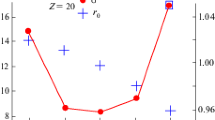Abstract
Surface tension coefficients of even–even nuclei are estimated using a relation that includes rigidity with respect to root-mean-square deformation. The effect surface tension has on the neutron and proton distribution is discussed. A relationship between surface tension coefficients and the neutron skin effect is revealed.
Similar content being viewed by others
Avoid common mistakes on your manuscript.
INTRODUCTION
The crucial role of surface tension in the formation of nuclei properties was established using the drop nuclear model [1]. The relationship between coefficient σ of the surface tension of even–even nuclei with nuclear surface rigidity C relative to quadrupole oscillations was shown by A. Bohr in [2]:
The rigidity of even–even nuclei C in the ground state can be estimated from the energy of the lower 2+ level of the even–even nucleus and root-mean-square deformation β:
Probabilities of 2+ → 0+ transitions in even–even nuclei are related to values of root-mean-square deformation β. A series of experimental investigations of these values was summarized in [3]. (Some of the results in [3] were refined in [4].) These data allowed us to calculate rigidity for most even–even nuclei [5].
Relation (1) between surface tension coefficients σ in atomic nuclei and nucleus rigidity C allows us to obtain approximate estimates for σ and study the relationship between these quantities and the shell structure of nuclei [6].
A correlation between high values of C and σ and the minima in parameters r0 = RchA−1/3 was revealed in [5, 6]. An example of such correlations is the distribution of surface tension coefficients and values of parameters r0 in even isotopes of calcium (Fig. 1).
EFFECT OF SURFACE TENSION ON NEUTRON SKIN THICKNESS
Since the nucleon density of nuclei is inversely proportional to the cube of parameter r0, its reduction corresponds to compression of the proton component of nuclear matter. The correlation between high values of rigidity and the minima in the density distribution of the atomic nucleus charge is a consequence of the surface tension influence on the nucleus shape and size. An increase in the surface tension coefficient raises the pressure on a sphere of radius R, which is reflected by the classical Laplace formula p = 2σ/R. Despite the weak compressibility of nuclear matter, an increase in surface tension (and thus a rise in pressure on the nucleus) results in minimal values of parameter r0. (The data on nucleus radii used in calculating coefficients σ [7] are the result from measurements on electron accelerators and reflect the charge distribution radius.)
Filling (1d3/2)4(1f7/2)8 neutron subshells in 48Ca results in the maximum coefficient of surface tension for all light nuclei. The spatial localization of nucleons at these subshells corresponds to higher values of mean radius rn for them, compared to mean radius rp of the proton distribution. The drop in values of the mean radius of the proton distribution in the same nucleus, caused by the increase in surface tension, is therefore a complementary factor for the increase in the difference
Value (3) quantitatively characterizes the thickness of the so-called neutron skin. Measurements and calculations of this quantity have been considered in many works (see, e.g., [8] and references therein). Values of Δrnp were measured on the MAMI accelerator on pion beams in the 208Pb nucleus [9] and estimate Δrnp = 0.15 ± 0.03 fm was obtained for them. Calculations of the surface tension coefficients in even lead isotopes [6] also testify to the effect of the smaller radius of the 208Pb proton component (Fig. 2).
Analysis of the relationship between surface tension coefficients in even–even nuclei with shell effects [10] revealed, in addition to 48Ca and 208Pb, several more even–even nuclei for which the discovery of the neutron skin effect is also possible. Zirconium isotopes 90Zr and 96Zr are most promising in this respect (Fig. 3). As with even–even calcium and lead isotopes, the distribution of coefficients σ and parameters r0, also testifies to the compression effect for the proton component of a nucleus at high values of the coefficient of surface tension. The shell structure of these nuclei indicates the successive filling of surface neutron levels. If the 90Zr nucleus has ten neutrons on the outer subshell, the last 96Zr subshells correspond to structure \(({\text{1}}{{g}_{{{9 \mathord{\left/ {\vphantom {9 2}} \right. \kern-0em} 2}}}})_{n}^{{10}}({\text{2}}{{d}_{{{5 \mathord{\left/ {\vphantom {5 2}} \right. \kern-0em} 2}}}})_{n}^{6}\). An additional neutron subshell with six neutrons reduces parameter r0, relative to 90Zr (i.e., it results in a moderate increase in the proton density).
CONCLUSIONS
Calculations of surface tension coefficients of even–even nuclei demonstrate the effect filled proton and neutron subshells have on the spatial distribution of nucleons. The highest coefficients of surface tension are limited to magic nuclei with two successively filled outer neutron subshells.
REFERENCES
von Weizsäcker, C.F., Z. Phys., 1935, vol. 96, p. 431.
Bohr, A., K. Dan. Vidensk. Selsk., Mat.-Fys. Medd., 1953, vol. 27, no. 16, p. 1.
Raman, S., At. Data Nucl. Data Tables, 2001, vol. 78, p. 1.
Pritychenko, B., Birch, M., Singh, B., et al., At. Data Nucl. Data Tables, 2016, vol. 107, p. 1.
Goncharova, N.G., Dolgodvorov, A.P., and Sergeeva, S.I., Moscow Univ. Phys. Bull. (Engl. Transl.), 2014, vol. 69, no. 3, p. 237.
Goncharova, N.G., Phys. Part. Nucl., 2019, vol. 50, no. 5, p. 532.
Angeli, I. and Marinova, K., At. Data Nucl. Data Tables, 2013, vol. 99, p. 69.
Thakur, V. and Dhiman, S., Nucl. Phys. A, 2019, vol. 992, 121623.
Tarbert, C.M., Watts, D.P., Glazier, D.I., et al., Phys. Rev. Lett., 2014, vol. 112, 242502.
Goncharova, N.G., Moscow Univ. Phys. Bull. (Engl. Transl.), 2020, vol. 75, no. 5, p. 440.
Author information
Authors and Affiliations
Corresponding author
Additional information
Translated by A. Nikol’skii
About this article
Cite this article
Goncharova, N.G., Dolgodvorov, A.P. Effect of Neutron Shells on Surface Tension in Atomic Nuclei. Bull. Russ. Acad. Sci. Phys. 85, 527–529 (2021). https://doi.org/10.3103/S1062873821050087
Received:
Revised:
Accepted:
Published:
Issue Date:
DOI: https://doi.org/10.3103/S1062873821050087







